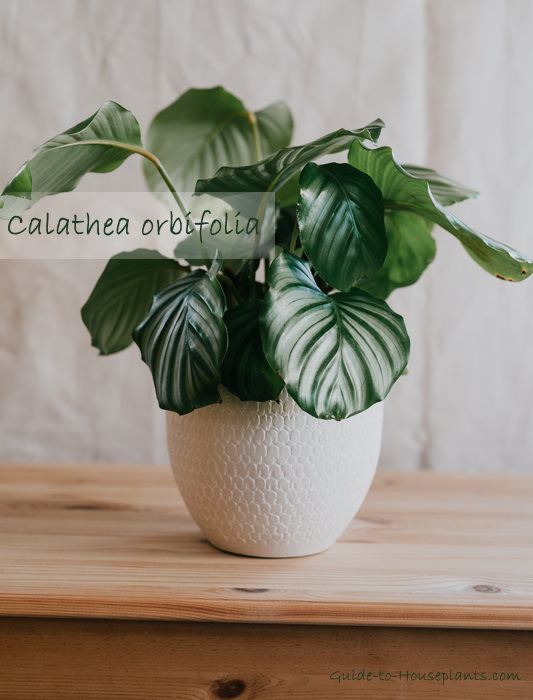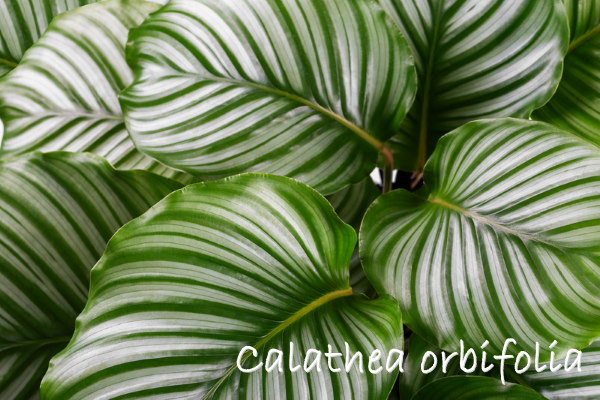Calathea Orbifolia
Botanical Name: Calathea orbifolia
Bold, silvery green stripes across big, broad leaves make this South American native a stand-out in any indoor plant collection.
A newcomer to the houseplant scene, it's already joined in the popularity of the prayer plant family. One glimpse at that exquisite foliage shows why. It's a decorator's dream.
 Decorative foliage makes this Calathea a must-have houseplant. Photo © Eva Peters
Decorative foliage makes this Calathea a must-have houseplant. Photo © Eva PetersNew leaves emerge from the center of the plant, eventually growing about 10-inches (25 cm) long. It's a lush, full plant that needs a little fussing over to thrive indoors.
The keys to keeping Calathea orbifolia happy is to water frequently and boost humidity around it. If you can maintain the moisture this tropical plant demands, you'll enjoy your houseplant for many years.
Calathea Orbifolia Problems, Solutions and Answers
Brown leaf tips are likely caused by dry air. This South American native thrives in high humidity. Short of turning your home into a misty rain forest, you do have a few options here. Bathrooms are sometimes a good location for tropical plants because of the high humidity; but only if it has enough light streaming in. A room humidifier works wonders, especially during the winter months, when indoor air can become extremely dry.
Dry, brown scorch marks on leaves are caused by hot, direct sunlight. Keep your Calathea orbifolia in bright light, but out of direct sun.
Leaves not unfolding? Calatheas that keep their leaves folded up night and day are likely too dry. This rain forest native likes moisture -- don't forget to water and maintain humidity around it.
Wondering when to repot? When your Calathea is crowded in its pot, the crown of the plant is pushing up out of the potting mix, or when you see roots growing out of the drainage holes, it is definitely time to repot. Spring is the best time, when your plant is beginning its most vigorous time of growth. Wait about a month before feeding a newly repotted plant; some roots will likely break while repotting and may get fertilizer burn.
Is Calathea orbifolia poisonous? No, it is safe for cats, dogs and people.
Something Bugging Your Plant?
Webbing between leaves is often the first tell-tale sign of spider mites. Unfortunately, these tiny critters will do a lot of damage, sucking sap from the undersides of the leaves. Left untreated, they multiply rapidly, causing leaves to look dry, and mottled with yellow spots. Spider mites prefer warm, dry conditions. Maintaining high humidity around Calathea orbifolia will do double-duty, giving this tropical plant the moisture it craves and discouraging an attack.
Consistently moist peat-based potting mixes attract fungus gnats. You may find these tiny, fly-like pests hopping and crawling on the surface of the potting mix. They're not particularly destructive, but they multiply quickly and will move on to your other indoor plants.
Aphids are attracted to soft, new growth on houseplants. They're tiny -- sometimes green, black or gray -- and can be found along young stems and leaves. Sucking plant juices, aphids cause new growth to curl, become distorted or discolored. You may find honeydew -- a sticky excretion left on leaves or dripping off the plant onto furniture. Treat any infestation immediately.
 Close-up of magnificent Calathea orbifolia leaves. Photo © Svitlana Malamatidi
Close-up of magnificent Calathea orbifolia leaves. Photo © Svitlana MalamatidiCalathea Orbifolia Care Tips
Origin: South America
Height: Up to 2 ft (60 cm)
Light: Moderate to bright, indirect sunlight. Hot, direct sun will cause leaves to turn brown.
Water: Aim to keep the potting mix lightly moist; never allow it to dry out. It's a good idea to pot Calathea orbifolia in a container with drainage holes. Water thoroughly, then empty the drainage tray to prevent root rot. Avoid overwatering, which will cause crown rot.
Humidity: Calatheas love high humidity, and this tropical houseplant is no exception. Try to maintain 60% relative humidity year-round. It's a good idea to use a cool-mist room humidifier near your plant.
Temperature: Average to warm room temperatures (65-80°F/18-27°C) year-round. It will tolerate a low of 60°F/16°C.
Soil: Peat-rich potting mix; African violet potting mix is ideal.
Fertilizer: Feed monthly spring through fall with a balanced (such as 10-10-10 NPK) water-soluble fertilizer.
Propagation: Division; divide large plants in spring. Calathea orbifolia can be divided if it has grown an offset plant (one that has a separate stem with leaves attached). Here's how to divide it: Pull the whole plant out of its pot, then gently separate the offset plant, keeping as much of the roots attached as possible; pot up the new offset in its own pot. Add more potting mix as needed and water thoroughly.


